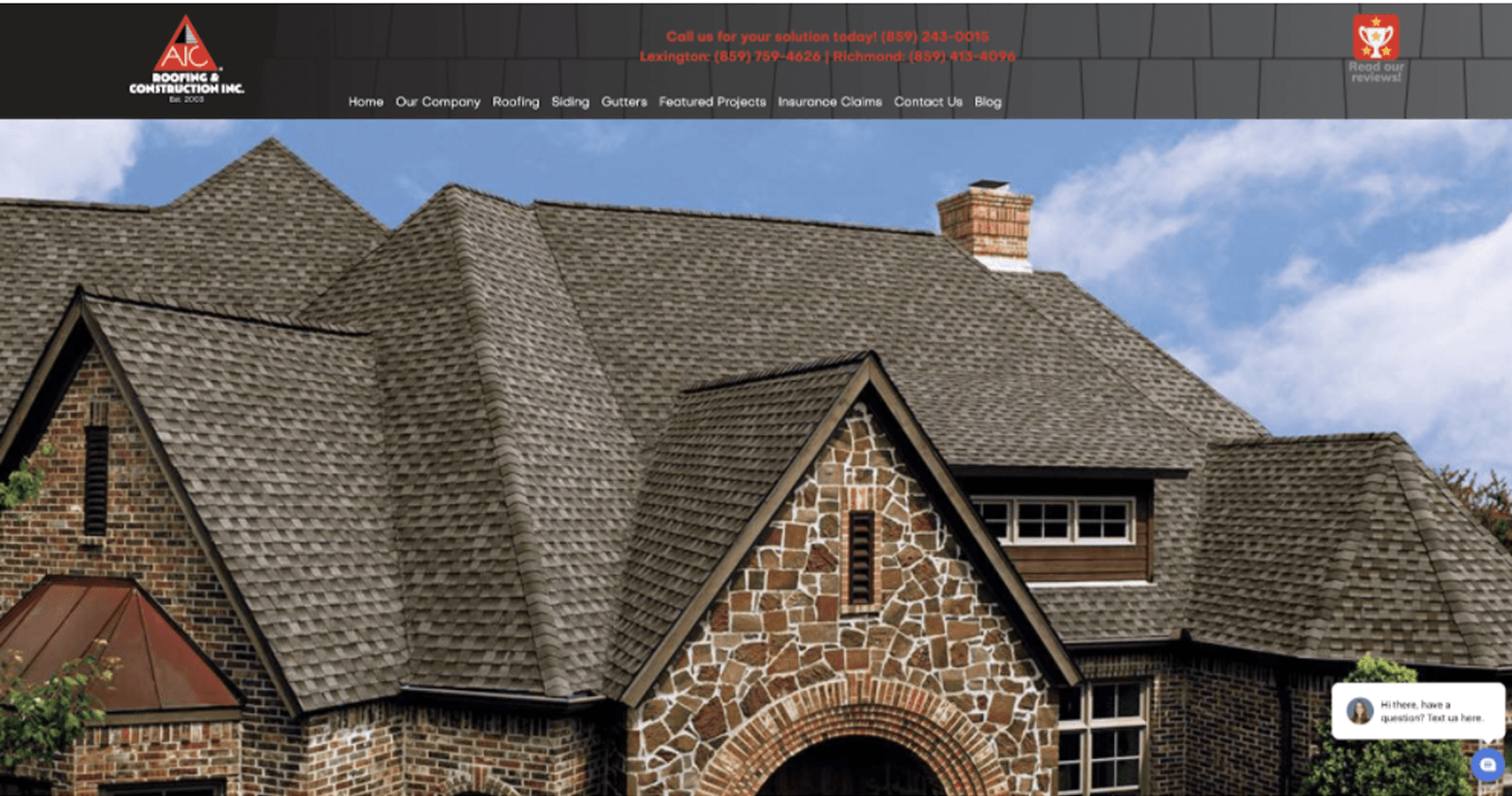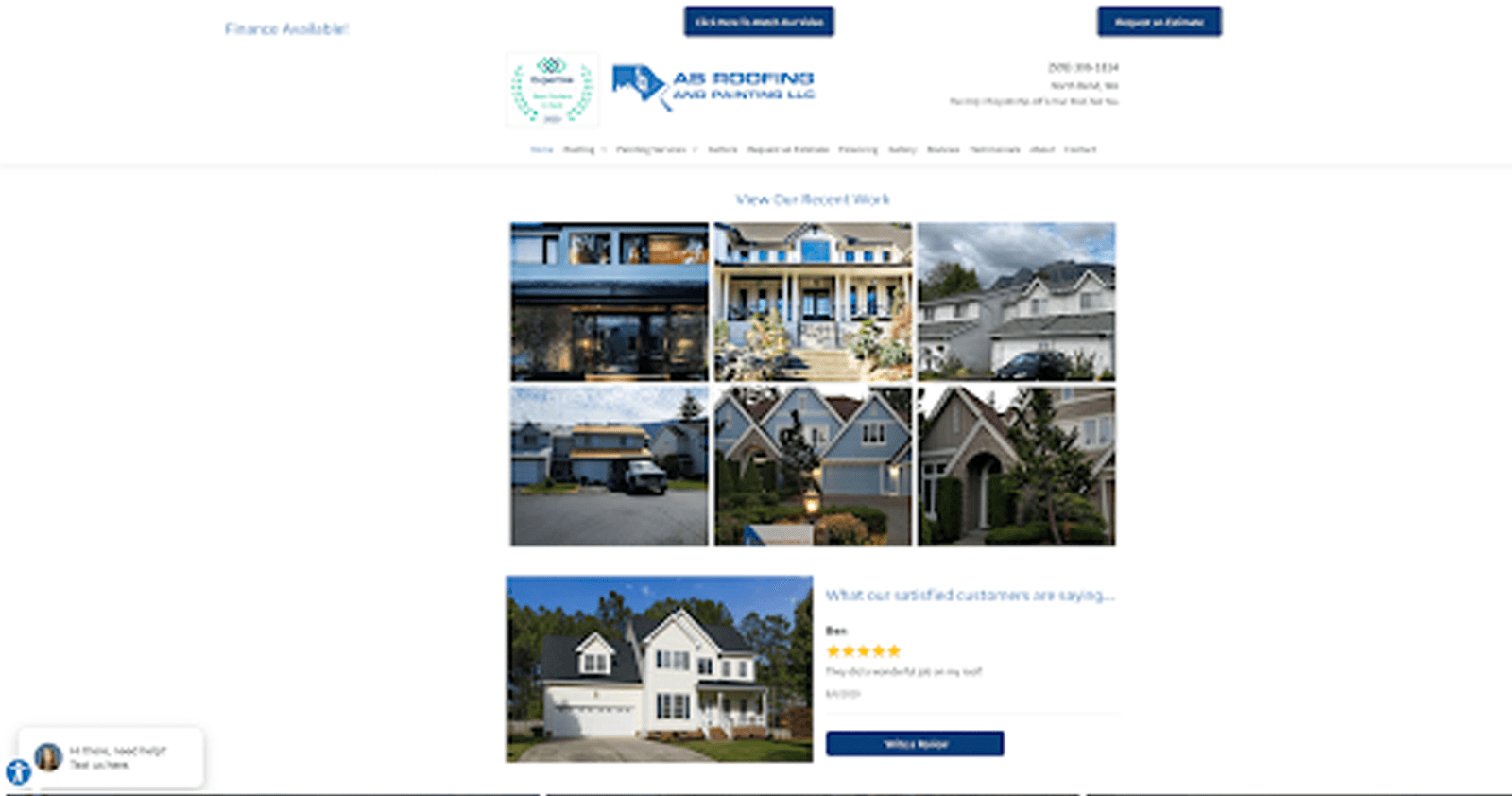Few things can make or break your roofing business quite like your website. Whether you’re a one-person operation or a nationwide roofing empire, your website is the door to your business. In fact, 97% of people learn more about a local company online than anywhere else. That’s why you can’t afford to have a website that doesn’t convert. What do the best roofing websites have in common? That’s what this article is all about. We’ll cover seven of the most essential aspects of the best roofing websites out there.
To start, go to your business website’s homepage. You’ve probably visited your website hundreds of times by now, but this time try to see it through fresh eyes. Pretend you’re a homeowner landing on your website for the first time. What is your initial reaction? What are you learning about this roofing company by simply seeing their website’s homepage? Believe it or not, 75% of consumers judge a business’s credibility by its website’s design. Does this business seem professional and trustworthy? Do they seem like they’re easy to contact and communicate with? Take a moment to jot down a few things that you would change about your website after seeing it through fresh eyes.
Now that you’ve put yourself in the shoes of your website visitors let’s dive into the top seven ways you can improve your website so that it converts more often.
1. The best roofing websites are minimalistic.

Here’s the thing: it takes about 50 milliseconds (that’s 0.05 seconds) for users to form an opinion about your website, which in turn determines whether they’ll stay or leave. Further, 94% of negative website feedback is design-related. Considering both of these factors together, you must design your website properly. One of the best examples we’ve seen of a minimalistic, well designed website is Scudder Roofing. Using a quality hero image, they let their results speak for themselves, keeping copy to a minimum. Say what you will about their website, the one thing you can’t say is that it’s sloppy or cluttered. Notice how much they’re communicating without having to say it. Without using any text to communicate it, their website designs demonstrate that their business provides quality results and is easy to work with. Rather than overwhelm the visitor with text, they keep their message simple. Even better, they keep their website menu minimalistic. One of the most common mistakes roofing websites make is having too many menu options.
2. Focus your content on the audience’s main pain point.

Website visitors care less about your business’s story than they do about how your business can solve their problems. While telling visitors about your company mission or background can be worthwhile, showing customers that you understand their world and their problems is essential.
Valentine Roofing demonstrates this concept well on their homepage. For one, the banner at the top of their website tells visitors that they should “get three bids, just make sure one of them is Valentine Roofing.” Right off the bat Valentine Roofing is resolving one of the most common pain points roofing clients have: getting a bid they can trust. After resolving the concern about getting a bid, Valentine Roofing jumps straight to one of their audiences most common needs—old, leaky roofs. Leading with the headline: “Leak Stop Guarantee”, they 80% will read your headline; only 20% will read the rest.
3. Make sure your website is consistent with your GMB page.

While your website is the door to your business, Google is the door to your website. And when it comes to local search, nothing is quite as important as your Google My Business (GMB) listing. Optimizing your GMB listing isn’t just about having complete information; it’s about making sure that information that matches your website. 180 Contractors demonstrates how to do this well. Notice the accurate business name, logo, hours of operation, description, etc. Once you’re ready to dive a little deeper into GMB, here’s a free Google My Business 101 guide.
4. Make it as easy as humanly possible to contact your business.

How many people end up bouncing from your website without engaging? If you’re not sure, this is a metric to which you should pay close attention. Imagine how much lost revenue that fraction represents. One of the most common reasons visitors leave a local business website is because it takes too long to find the business’s contact information. More precisely, 44% of website visitors exit a website that fails to display contact info.
Bell Roofing Company’s website is a great example of clearly displaying contact information. In the top ribbon of their site they include their physical address, phone numbers for both of the areas they serve, hours of operation, and a button to “get a quote (any time day or night)”.
5. Add a website chat function to your site.

Including your business phone number or a contact form on your homepage is one thing, but what if you could let visitors message your business with the click of a button? Good news—you can. All you have to do is add a website chat function, like Podium Webchat, to your website. You can even test Podium Webchat on your own website right now—no code required.
We live in a world of on-demand everything where people can get almost anything at the click of a button. That’s why today’s consumer has embraced website chat. In fact, more than half of all customers prefer to chat with someone in real-time and online, rather than call a company for support. In other words, you can’t afford to not have a chat function on your business website. Notice how inviting AIC Roofing & Construction’s website is and how easy it would be to connect with them to ask a question by simply clicking on the Webchat widget in the bottom-right corner of their website. Even better, no matter what page you navigate to on their site, the Webchat widget follows you. Whenever you’re ready to reach out, it’s there.
6. Include testimonials and reviews on your website.

Perhaps nothing influences consumers more than online reviews. In fact, 87% of consumers say reviews influence them in discovering a local business. Further, 23% of consumers have read an online review in the last day, and 65% have read one in the last week. But having effective reviews isn’t just about the star rating of the number of reviews; it’s also about how recent and relevant those reviews are—83% of consumers say that reviews must be recent and relevant in order to care about them
AB Roofing & Painting is a great example of including reviews on a roofing business website. Below the section that displays some of their recent work, you then receive the social validation that you’re making a good choice by going with AB Roofing & Painting. Not only can you see recent reviews they’ve received, but there’s also a button to leave a review, helping their business keep a steady flow of incoming reviews. However, there’s an even better way to get more reviews. Using a tool like Podium Reviews can take the pain out of getting reviews. Instead of asking customers over the phone or sending an email invite, Podium allows you to send an invite via text. Why text? Because while email only gets about a 20% response rate, 98% of texts get opened.
7. Provide a clear call-to-action (CTA).

Everything we’ve covered up to this point is in vain unless visitors know how to take action on your website. That’s where the call-to-action (CTA) comes in. A CTA is any button, link, form, or other action that moves visitors one step closer to making a purchase.
Devore Roofing is a great example of giving visitors a clear CTA. Directly below the headline in their homepage hero, Devore Roofing has provided two buttons: “Schedule an Appointment” and “Request Pricing”. If you go back up through the previous examples provided, many of them have missed this crucial aspect of website design. But Devore Roofing’s website makes it clear what visitors need to do to start the process of doing business with them. Instead of overwhelming visitors with options, they narrow it down to only those two.
Conclusion: optimizing your roofing website is easier than it seems.
While many other strategies for optimizing your website exist, the seven above are a great way to get started. Instead of overwhelming you with difficult tasks requiring full-time developers and expensive investments, we’ve focused on seven simple steps that you can do right away. Once you’ve completed these seven essential steps and you’re ready to go deeper, take the next step by learning what every website needs to win leads locally.
Want to make things even easier for your business? Podium makes everything you do to grow your business as easy as sending a text. Once your website is optimized, Podium will help you bring more visitors to your site by helping you improve your online reputation. But that’s not all—Podium also makes communicating with your customers and getting paid as easy as sending a text.
This article is part of our Roofing Small Business Guide:



